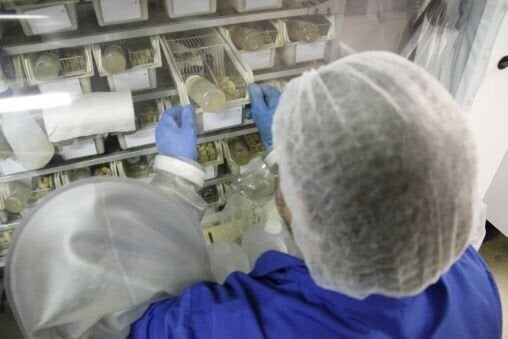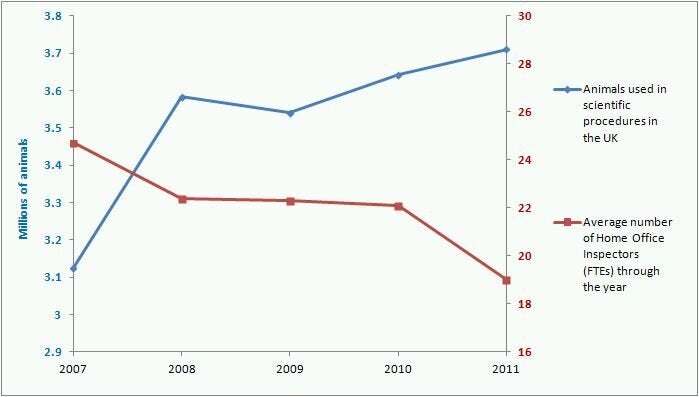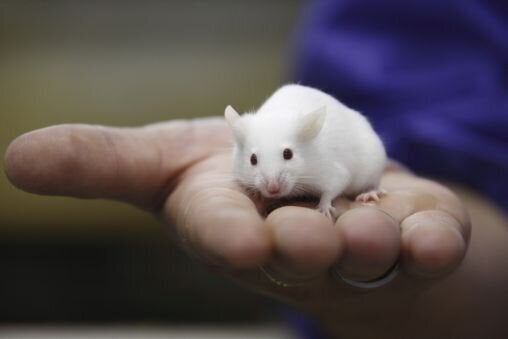In the coming days, MPs and Lords are expected to pass new UK legislation on animal experimentation.
Since a new European Directive on this issue - the catalyst for our own new law - was agreed back in 2010, some in the commercial and academic sectors have been actively lobbying the UK government, eyeing an opportunity to push for a 'lighter touch' of regulation.
However, many more people, as well as the RSPCA, have been arguing against any weakening of our controls and standards. Now the dust has settled, it would appear that for the most part, the Government has chosen to maintain the status quo. Not the backwards step once feared then, but not really progress either.

Home Office figures released in July show that more animals are now being used in research than at any other point over the past 20 years.
At the same time, a poll commissioned by the Department for Business, Innovation and Skills, and released last month, found that public support for animal use has been steadily falling by around 2% each year since 2009.
Around one in three adults now agrees with the statement: "I do not support the use of animals in any experimentation because of the importance I place on animal welfare" - a stark and timely reminder that the public is deeply concerned about animal suffering in the name of science.
The present government should take the drop in public confidence that the rules on animal experimentation are being well enforced (from 56% in 2010 to 43% in 2012) extremely seriously.
Reduction in number of inspectors
Confidence is likely to fall even further if recent reductions seen in the number of Home Office inspectors, and in the number of visits they make to research and testing facilities, both continue.
For example, there was a 27.6% fall in the number of visits between 2010 and 2011 - despite animal numbers rising yet again. It is certainly not unrealistic to predict that this could result in standards slipping in some establishments.

The use and suffering of animals in experiments is a persistent and legitimate public concern. Both the government and the scientific community have recently set up initiatives that attempt to convince a sceptical public that their concerns are understood and taken seriously.
When the Coalition Government came to power, it fanfared two pledges to help laboratory animals. The intention to 'ban the use of animals to test household products' was risible, because it will have little or no effect in practice (zero animals were used for this purpose in 2011 anyway).
No new strategy for pledge
The second pledge, however, was to 'work to reduce the use of animals in research', which could - if properly resourced and implemented - actually make a difference. But disappointingly, no new overall strategy or additional resources have been forthcoming to facilitate this pledge.
Indeed, the National Centre for the Replacement, Refinement and Reduction of Animals in Research (NC3Rs), which was then tasked by the Government to lead the delivery on this aim, still receives little more than £5 million out of an annual government budget for science and research of £4.7 billion.
In another move designed to win public confidence and convince them that animal research is 'right', a new declaration on 'openness in animal research' was recently trumpeted by a number of bodies including major funders of animal research, and establishments and companies using animals.
Such openness is to be welcomed, but only if people are honest about why and how research is conducted; the likelihood of achieving real benefits; and the serious costs in terms of animal suffering.
We had hoped that this initiative would avoid simply repeating the usual implausible platitudes that everyone involved in animal research always does everything to, not just good, but the 'highest possible' standards.
But the signs so far do not encourage optimism. It is all very well for the declaration to make bold assertions that the UK has 'the world-leading ethical framework' and that all research 'meets the highest welfare standards', but this has to be backed up with evidence.
If the standards referred to are no better than those explicitly set out in legislation, as is usually the case, then they are anything but the 'highest possible' in animal welfare terms. We need to see real commitment to reducing animal use and suffering, not just more banal attempts to play down animal suffering and overhype the benefits of research.

Critical challenge
There is now, however, a movement from some within the scientific community to develop the debate on animal experimentation and this should be applauded.
Away from the PR speak and gloss from research industry lobbyists, the scientific value of many traditionally used animal 'models' is being openly, constructively and increasingly questioned by many scientists and healthcare clinicians. Others are critically examining the way that animal studies are designed, carried out and reported, and urging colleagues to do better. But significant challenges remain.
There is a clear need for a robust, challenging and well-enforced regulatory system which ensures that animals are only used where there is an urgent need and absolutely no other alternative, and that everything possible is done to avoid, or at least minimise, any suffering.
This must be coupled with honesty about why animals are used and how much they actually suffer, along with meaningful action and resourcing to back up the fine words in 'pledges' and 'declarations'.
Only this will ultimately lead to a better outlook for science, people and animals.